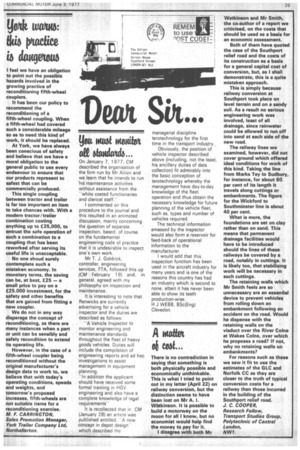You mud eittuiiitvi at otowleults...
Page 41

If you've noticed an error in this article please click here to report it so we can fix it.
On January 7, 1077, CM described the organisation of the firm run by Mr Ailion and we learn that he intends to run his maintenance activities without assistance from the "white coated functionaries and clerical staff."
I commented on this procedure to the journal and this resulted in an animated discussion, mainly concerning the question of separate inspection, based, of course, on the fundamental engineering code of practice that it is undesirable to inspect. one's own work.
Mr T. J. Goldrick, controller, engineering services, FTA, followed this up (CM February 18) and, in general, agreed with my philosophy on inspection and maintenance.
It is interesting to note that Renwicks are currently advertising for a vehicle inspector and the duties are described as follows: "A Vehicle Inspector to monitor engineering and maintenance standards throughout the fleet of heavy goods vehicles. Duties will include the compilation of engineering reports and ad hoc investigations to assist management in equipment planning.
"In addition the applicant should have received some formal training in HGV engineering and also have a complete knowledge of legal requirements"
It is recollected that in CM (January 28) an article was published entitled, -A new concept in depot design"' which described the managerial discipline terotechnology for the first time in the transport industry.:
Obviously, the position of vehicle inspector described above (including, not the least, his ancillary duties of data collection) fit admirably into the basic conception of terotechnology whereby the management have day-to-day knowledge of the fleet operation and thus obtain the necessary knowledge for future planning of the vehicle fleet, such as, types and number of vehicles required.
The technical information amassed by the inspector would also form a reservoir for feed-back of operational information to the manufacturer.
I would add that this inspection function has been used in the aircraft industry for many years and is one of the reasons this country has had an industry which is second to none, albeit it has never been able to show its teeth production-wise.
H J WEBB, BSc(Eng) Clevecion.




















































































































